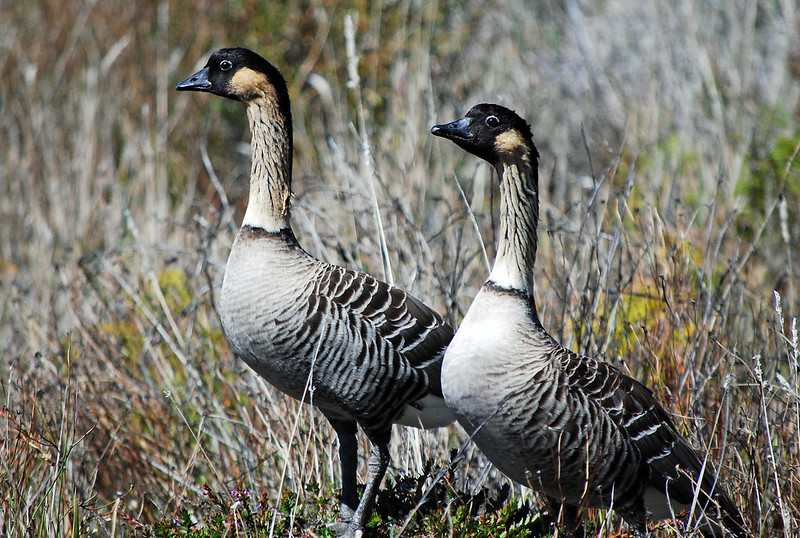by Paul Wood
Before humans arrived less than two thousand years ago, Maui was covered in forest. And the forest swirled and rang with small, brightly colored birds that we call “honeycreepers.” These birds had no predators. They lived on flowers and insects, and in so doing they groomed the forest, kept it healthy.
When humans arrived, life changed. Today, honeycreepers can only be found in the remotest upper slopes of Haleakalā. What might have been twenty species on Maui are now just six. Two of these six, having thrived for millions of years, could soon vanish forever.
The ʻākohekohe is a high-energy nectar-eating bird with a sassy white topknot. It speeds through the forest canopy as if running with its long legs. A recent count of living ʻākohekohe birds totalled just 1,768.
The kiwikiu or Maui parrotbill, a wee yellow-green featherball, uses its nutcracker beak to crush dead branches in search of insect larvae. Last count—just 157.
If you were writing the screenplay with a rescue plot, you would be at your witʻs end trying to come up with a Hollywood ending for this one.
And yet a partnership of scientific groups—federal and state agencies allied with conservation nonprofits—have devised a last ditch plan to save these wild birds within in the next few years (Hooray!) But the plan involves importing millions of mosquitoes to Maui. (Huh?) Understandably, some folks are worried. The proven science behind this plan gets a little complicated to explain, so please read on.
THE HONEYCREEPERS
These Pacific islands, unlike any other lands on earth, popped up smack in the middle of the planetʻs largest expanse of salt water. All other lands have been situated close enough to neighboring acreage to allow relatively easy migration of terrestrial species. Here, though, (until humans built boats) it took a near-miracle for any land creature to float, drift, or fly this far. Even so, some six million years ago, a little Asian finch managed the trip.
At that point, Maui didnʻt yet exist. Only the oldest of our major islands had formed—Kauaʻi and Niʻihau. As islands arose and new habitats came available, descendants of that founding finch adapted into 50 or more new species, variations on the original theme. Some became nectar sippers and seedpod crunchers,
others ate insects. Each distinct species developed its own billshape designed to dig under bark or crunch twigs or poke deep into flowers. They developed different songs and mating habits.
But these “honecreeper” species all retained the basic pattern— small, lively birds of the forest.
When Polynesians arrived, they cleared some tracts of forest, and they introduced rats and pigs. Even so, the honeycreepers remained abundant. The Hawaiians valued their colorful feathers, which became a kind of currency, symbols of status. Still, these humans respected the birds and practiced a pluck-and-release policy. For the most part, they treated the forest and its critters with respect.
MOSQUITOES
Western contact changed everything. Today only 17 of the original 50-plus honeycreeper species still exist, and 11 of those are considered endangered or threatened under the U.S. Endangered Species Act.
These extinctions happened, in part, because Hawaiʻiʻs forests shrank. The honeycreepers lost habitat to Western-style agriculture, to the appetites of cattle and goats, also to the crowding-out out of native plants by super-aggressive weeds.
No forest, no forest birds.
But the most urgent and fatal threat today is the mosquito. One of the ugliest sights in the world is the image of a mosquito casually sucking on the eyelid of a bird with no ability to shoo it away. For humans
such a bite is irritating. For a honeycreeper the result is often death in as few os nine days.
Mosquitoes carry Avian Malaria. (“Avian” means “of birds.”) Some species of honeycreeper, over time, have developed a level of immunity to this disease. But the ‘ākohekohe and the kiwikiu are running out of time.
The first mosquitoes came to Hawaiʻi in 1828. The site: Lahaina. According to some, sailors aboard a visiting whaler were furious to discover that the missionaries had succeeded in closing the brothels and Christianizing the population. To express their outrage, they rowed to shore with a water cask infested by mosquito larvae, and they dumped it into a pond. We know this because the incident was recorded in the shipʻs log.
Of course, mosquitoes would have got here at some point anyway. Four species of mosquito are now part of the Maui scene. And if none of these original pests had carried Avian Malaria, they would have picked it up from imported songbirds. Itʻs said that when people began noticing there were fewer and fewer native birds around, they began bringing in replacements—cardinals, mockingbirds, parakeets, species with a long history of resistance to the disease. Most native forest birds could only survive where the mosquitoes werenʻt.
Fortunately, mosquitoes canʻt take the cold. On Haleakalā, mosquitoes would fall back when they ran out of warmth. The temperature at a certain elevation acted as an invisible fence (so to speak) to keep the wolves out of the chicken coop.
So now our honeycreepers tend to live around Haleakalā in a band. The upper edge of the band is the timberline, the point at which the forest ceases. The lower-elevation boundary, however, is open and nebulous. Now that the planet, as predicted, is warming, that invisible fence is beginning to fall apart.
A RADICAL RESCUE PLAN
Extinction is such a sad, slow process. If only we could get the mosquitoes to go away. We canʻt poison the whole mountaintop and wipe them all out. But couldn’t we come up with a plan to just reduce their numbers somehow? Push them back? Suppress them?
Itʻs good you ask, because there is such a plan, and it is being deployed now, in 2023. The partnership that
is driving this complicated rescue plan includes the U.S. Fish and Wildlife Service, The Nature Conservancy, the State Department of Land and Natural Resources, the Hawaiʻi Department of Health, and the National Park System. What will happen has been used with success all over the world from California to New Caledonia—on humans. It has been used successfully to reduce the occurrence of human diseases, such as dengue, that are carried by mosquitoes. The process is so intricate that no one would have bothered to work
it up for a few rare birds, but if it works for humans, it will work for the kiwikiu.
Itʻs called IIT—Incompatible Insect Technique. Others are calling it “Mosquito Birth-Control.” It involves collecting lots of eggs from mosquitoes in Hawai’i, taking them to a lab on the Mainland, and hatching them in such a way that they will be reproductively useless on Maui. Then, after the lab eliminates all the newly hatched females, the useless males are brought to Maui.
Female mosquitoes mate just one time in life. So if a great abundance of these introduced gents arrive, the females will tend to mate with them, and no offspring will result. Repeat the process, and repeat; the mosquito population will shrink. The result will be suppression, not total elimination, but it will not entail toxic chemicals or disruption of the landscape. It will only require millions of these incompatible males delivered frequently enough to turn the population dial down to “rare.”
Whatʻs behind this is the discovery of something odd about mosquitoes. They, like 50 percent of all insects, have a naturally occurring bacteria in their guts. Itʻs called Wolbachia. (This is an insect thing with no
bearing on mammals.) If two mosquitoes have the same strain of Wolbachia, mating will succeed. But if the
strains are different—for example, the males were raised in a lab located elsewhere, theyʻll come home and mate happily and unproductively. Properly managed, this elaborate process will work exactly as it has all over the globe with human diseases.
Haleakalā mosquito populations will decline, and our honeycreepers will thrive.
NUMBER-ONE FEAR
Question: Am I going to bitten by all those millions of mosquitoes? My god, donʻt we have enough of them already?
Answer: Theyʻre all male mosquitoes. Male mosquitoes donʻt bite. Besides, theyʻre all going to be released at the top of the mountain. They donʻt fly very far. They live just a couple of weeks. Chill.
For more information about this topic, readers can study an informational briefing posted by the State
of Hawaiʻi Department of Land and Natural Resources on March 10 of this
year. Go to https://dlnr.hawaii.gov/wp-content/uploads/2023/03/C-2.pdf

